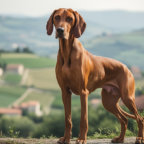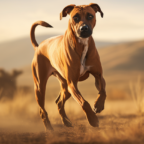Click and GO TO THE BEST DOG NAME GENERATOR HERE

The Cane di Oropa is a working dog breed that possesses a captivating origin and distinctive characteristics.
Recent genetic research conducted in 2018 has shed light on the ancestral lineage of the Cane di Oropa, revealing its descent from a European herding dog.
Renowned for its exceptional athletic ability, this breed’s aptitude is crucial in effectively managing flocks on treacherous mountain slopes.
Notably, many individuals of this breed exhibit a naturally bobtailed phenotype, characterized by a short or absent tail.
The Cane di Oropa’s coat can vary in length and texture, ranging from short to medium and smooth to somewhat rough.
Coat coloration encompasses a wide spectrum, encompassing merle, black, and various shades of brown.
Brown eyes are deemed desirable in this breed, while blue eyes are considered a fault.
With its remarkable obedience and invaluable working skills, the Cane di Oropa holds a prominent position in its designated role.
Overall, the intriguing origins and distinctive traits of this breed render it a unique and prized working dog.
Key Takeaways
- The Cane di Oropa is a working dog with great athletic ability, known for its obedience and capability in managing flocks on steep mountain slopes.
- The breed is one of the Italian herding breeds and is believed to have originated from a European herding dog, according to a genetic study conducted in 2018.
- Many Cane di Oropa specimens have naturally bobtailed, meaning they have a naturally short or absent tail.
- The coat color of the Cane di Oropa can vary, including merle, merle with black and tan markings, black, or different shades of brown, while blue eyes are considered a fault in the breed.
Origins and Evolution
The genetic study conducted in 2018 provided valuable insights into the origins and evolution of Cane di Oropa, along with other related Italian herding breeds, revealing their connection to a European herding dog.
This study utilized microsatellite markers to analyze the genetic diversity and structure of these breeds. The results showed that Cane di Oropa, along with Bergamasco Shepherd, Cane Paratore, Lupino del Gigante, and Pastore della Lessinia e del Lagorai, all share a common ancestry with a European herding dog.
This suggests that these breeds have a shared genetic heritage and have evolved from a common ancestor. The study also highlighted the importance of these herding breeds in the history and culture of Italy, as well as their significance in the working abilities and traits that make them well-suited for managing flocks in mountainous terrains.
Physical Description
Originating from Europe, the Cane di Oropa is a working dog breed known for its athletic ability and ability to manage flocks on steep mountain slopes. This breed exhibits a range of physical characteristics that contribute to its unique appearance and functionality.
-
The Cane di Oropa has a coat that can be short or medium-length, and it can be smooth or somewhat rough. The coat color varies and includes merle, merle with black and tan markings, black, or different shades of brown.
-
Many specimens of this breed have naturally bobtailed, meaning they have a naturally short or absent tail.
-
The eyes of the Cane di Oropa should be brown, and blue eyes are considered a fault.
-
With its great athletic ability, the Cane di Oropa is well-suited for running on steep mountain slopes, making them indispensable in their role as a working dog.
References:
- Talenti, A., Dreger, D.L., Frattini, F., Polli, M., Marelli, S., Harris, A.C., Liotta, L., Cocco, R., Hogan, A.N., Bigi, D., Caniglia, R., Parker, H.G., Pagnacco, G., Ostrander, E.A., and Crepaldi, P. conducted studies on modern Italian dog populations revealing multiple patterns for domestic breed evolution.
Working Abilities
With their exceptional working abilities, the Cane di Oropa is highly skilled in managing flocks on steep mountain slopes. These dogs possess great athletic ability, allowing them to run and navigate the challenging terrain throughout the day.
Their obedience and capability in managing the flock make them indispensable in their role as working dogs. The Cane di Oropa is known for its obedience, which is a crucial trait for effectively herding and controlling the flock.
Their athletic ability and agility enable them to traverse the mountainous landscape, ensuring the safety and well-being of the herd. This working dog breed has been specifically bred for its physical endurance, intelligence, and ability to adapt to different working conditions.
Their exceptional working abilities make them well-suited for their role as herders in the rugged and demanding environment of steep mountain slopes.
Genetic Study
A genetic study conducted in 2018 provided insights into the ancestry and evolution of the Cane di Oropa and other related breeds. The study revealed that a European herding dog played a significant role in the development of Cane di Oropa, along with other Italian herding breeds such as Bergamasco Shepherd and Cane Paratore.
This genetic analysis was conducted using microsatellite markers, allowing researchers to trace the lineage of these breeds. The findings shed light on the genetic diversity and population structure of Cane di Oropa, highlighting its unique traits and characteristics.
This study serves as a valuable resource for understanding the origins of Cane di Oropa and its relationship to other herding breeds. It provides a scientific basis for further research and conservation efforts for this remarkable working dog.
Frequently Asked Questions
Are Cane di Oropa dogs suitable for apartment living or do they require a large outdoor space?
Cane di Oropa dogs are not suitable for apartment living and require a large outdoor space.
Due to their working nature and great athletic ability, these dogs need ample space to exercise and roam freely. They are accustomed to running on steep mountain slopes and managing flocks, which necessitates a larger area for them to thrive.
Apartment living would restrict their physical activity and may lead to behavioral issues. Therefore, providing a spacious outdoor environment is essential for the well-being of Cane di Oropa dogs.
How does the Cane di Oropa compare to other Italian herding breeds in terms of temperament?
In terms of temperament, the Cane di Oropa, along with other Italian herding breeds, is known for its obedience and working abilities. They are highly obedient and capable of managing the flock on steep mountain slopes, which makes them indispensable in their role.
While there may be variations in individual temperament within the breed, overall, the Cane di Oropa shares similar temperament traits with other Italian herding breeds, such as being intelligent, alert, and focused on their work.
What is the average lifespan of a Cane di Oropa?
The average lifespan of a Cane di Oropa is not specifically mentioned in the provided information. While there is no direct evidence to determine the exact lifespan of this breed, it is generally believed that the lifespan of a Cane di Oropa is similar to that of other medium to large-sized working dog breeds.
On average, these types of dogs typically live between 10 to 13 years, although individual lifespans can vary based on factors such as genetics, overall health, and care provided.
Can Cane di Oropa dogs be trained for tasks other than herding?
Yes, Cane di Oropa dogs can be trained for tasks other than herding.
While their primary role is managing the flock on steep mountain slopes, their great athletic ability and obedience make them versatile working dogs.
They can be trained for activities like agility, obedience trials, and search and rescue.
Their intelligence and willingness to learn make them suitable for a variety of tasks, further highlighting their value as a multi-purpose working breed.
Are there any health concerns specific to the Cane di Oropa breed?
There are no specific health concerns that are unique to the Cane di Oropa breed. However, as with all dog breeds, there are general health issues that can affect them. These may include:
- Hip dysplasia
- Elbow dysplasia
- Eye problems
- Certain genetic disorders
It is important for owners of Cane di Oropa dogs to ensure regular veterinary check-ups, maintain a balanced diet, provide regular exercise, and monitor their overall health. This will help prevent and address any potential health issues.
We hope you enjoyed the article and see you in the next
Welcome to our ever-growing collection of Italian Dog Breeds! As we continually dive deeper into the marvelous world of these dogs, you can expect this list to expand further.
We’ve curated this selection for you to explore and enjoy. Remember, your experience matters to us! So, don’t hesitate to tell us which Italian dog breed tugs at your heartstrings the most.
What’s more, we’d absolutely love to see images of these captivating breeds from your personal collection. If you’d like to share, we encourage you to send them in! Immerse yourself in this delightful canine journey, and remember to share your favorites with us. Let’s celebrate the beauty of Italian Dog Breeds together!
Our wealth of information about Italian Dog Names comes from a diverse blend of resources, complemented by our own extensive knowledge. We’ve strived to create the most comprehensive online hub for everything related to Italian Dog Names, and we couldn’t have done it without some highly respected and incredibly useful references.
Whether you’re searching for the perfect Italian name for your canine companion, looking for Italian words and phrases for training, or curious about the various Italian dog breeds, rest assured that our content is thoroughly researched.
Our work is a meticulously woven tapestry of information that we’ve compiled from these trusted sources. As we continue to grow our website, we commit to maintaining this high standard of quality and accuracy in our content. So, sit back, explore, and enjoy your journey through the world of Italian Dog Names with us.
- Bergamasco Shepherd
- Bracco Italiano
- Cane Corso
- Cirneco dell’Etna
- Italian Dog Breeds article
- Lagotto Romagnolo
- Levriero Sardo
- Pyrenean Sheepdog
- Segugio Maremmano
- Volpino Italiano
- Spinone Italiano
- Cane di Oropa
- Italian Greyhound
- Rafeiro do Alentejo
- Segugio Italiano
Welcome to the heart of everything that revolves around Italian Dog Names! But we’re not merely stopping at offering you an array of charming names for your furry companion. Oh no, our dedication goes far beyond that.
With an earnest desire to enrich your bonding experience with your dog, we dive headfirst into the realm of Italian dog commands. An absolutely indispensable section, it aids in training your canine pal impeccably, regardless of whether you plan to use these Italian phrases or commands in your routine or not.
And then, we have a whole new section devoted entirely to the myriad Italian Dog Breeds. Here, we walk you through the wide-ranging breeds associated with Italy. Some of these, you might be surprised to learn, are often not perceived as Italian breeds. Yet, they share a rich and complex bond with Italy, either historically or otherwise.
Naturally, our list would be incomplete without spotlighting the authentic Italian dog breeds that are purebreds, with their lineage tracing straight back to Italy. These breeds are Italy’s very own, born and bred on its enchanting soil.
So, whether you’re a dog lover, an enthusiast for all things Italian, or simply curious, we invite you to immerse yourself in our website. Most importantly, revel in the unique charm of your Italian Dog Breed. We promise you an engaging journey, filled with delightful discoveries. Welcome, and enjoy the exploration!



